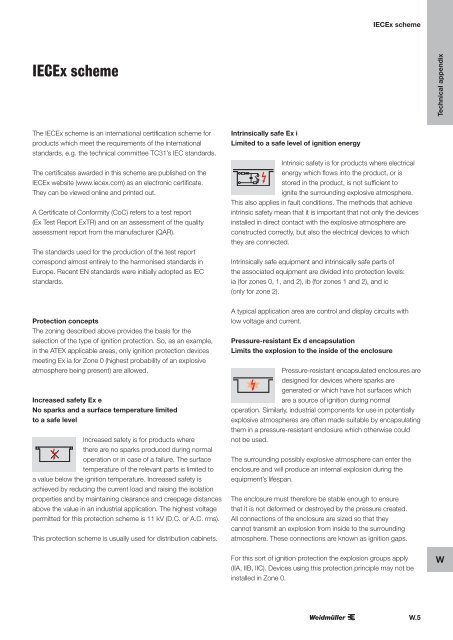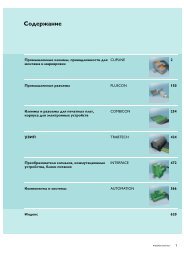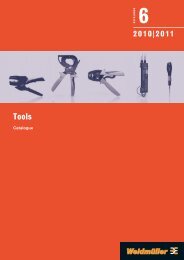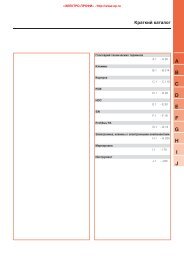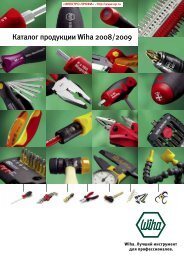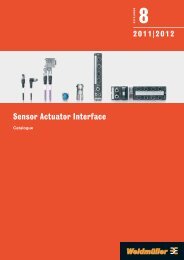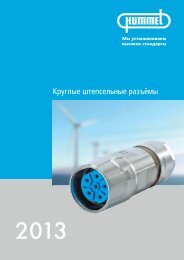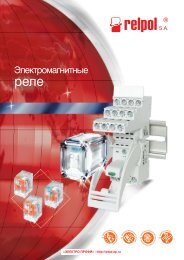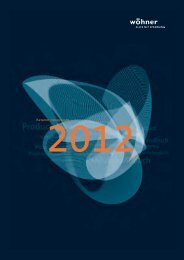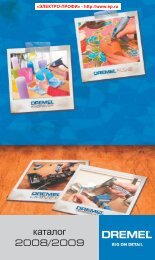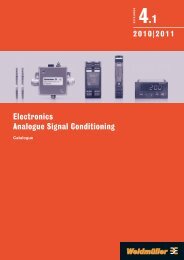ÐаÑалог Weidmuller: Enclosures and Cable Glands
ÐаÑалог Weidmuller: Enclosures and Cable Glands
ÐаÑалог Weidmuller: Enclosures and Cable Glands
You also want an ePaper? Increase the reach of your titles
YUMPU automatically turns print PDFs into web optimized ePapers that Google loves.
IECEx scheme<br />
IECEx scheme<br />
Technical appendix<br />
The IECEx scheme is an international certification scheme for<br />
products which meet the requirements of the international<br />
st<strong>and</strong>ards, e.g. the technical committee TC31’s IEC st<strong>and</strong>ards.<br />
The certificates awarded in this scheme are published on the<br />
IECEx website (www.iecex.com) as an electronic certificate.<br />
They can be viewed online <strong>and</strong> printed out.<br />
A Certificate of Conformity (CoC) refers to a test report<br />
(Ex Test Report ExTR) <strong>and</strong> on an assessment of the quality<br />
assessment report from the manufacturer (QAR).<br />
The st<strong>and</strong>ards used for the production of the test report<br />
correspond almost entirely to the harmonised st<strong>and</strong>ards in<br />
Europe. Recent EN st<strong>and</strong>ards were initially adopted as IEC<br />
st<strong>and</strong>ards.<br />
Protection concepts<br />
The zoning described above provides the basis for the<br />
selection of the type of ignition protection. So, as an example,<br />
in the ATEX applicable areas, only ignition protection devices<br />
meeting Ex ia for Zone 0 (highest probability of an explosive<br />
atmosphere being present) are allowed.<br />
Increased safety Ex e<br />
No sparks <strong>and</strong> a surface temperature limited<br />
to a safe level<br />
Increased safety is for products where<br />
there are no sparks produced during normal<br />
operation or in case of a failure. The surface<br />
temperature of the relevant parts is limited to<br />
a value below the ignition temperature. Increased safety is<br />
achieved by reducing the current load <strong>and</strong> raising the isolation<br />
properties <strong>and</strong> by maintaining clearance <strong>and</strong> creepage distances<br />
above the value in an industrial application. The highest voltage<br />
permitted for this protection scheme is 11 kV (D.C. or A.C. rms).<br />
This protection scheme is usually used for distribution cabinets.<br />
Intrinsically safe Ex i<br />
Limited to a safe level of ignition energy<br />
Intrinsic safety is for products where electrical<br />
energy which flows into the product, or is<br />
stored in the product, is not sufficient to<br />
ignite the surrounding explosive atmosphere.<br />
This also applies in fault conditions. The methods that achieve<br />
intrinsic safety mean that it is important that not only the devices<br />
installed in direct contact with the explosive atmosphere are<br />
constructed correctly, but also the electrical devices to which<br />
they are connected.<br />
Intrinsically safe equipment <strong>and</strong> intrinsically safe parts of<br />
the associated equipment are divided into protection levels:<br />
ia (for zones 0, 1, <strong>and</strong> 2), ib (for zones 1 <strong>and</strong> 2), <strong>and</strong> ic<br />
(only for zone 2).<br />
A typical application area are control <strong>and</strong> display circuits with<br />
low voltage <strong>and</strong> current.<br />
Pressure-resistant Ex d encapsulation<br />
Limits the explosion to the inside of the enclosure<br />
Pressure-resistant encapsulated enclosures are<br />
designed for devices where sparks are<br />
generated or which have hot surfaces which<br />
are a source of ignition during normal<br />
operation. Similarly, industrial components for use in potentially<br />
explosive atmospheres are often made suitable by encapsulating<br />
them in a pressure-resistant enclosure which otherwise could<br />
not be used.<br />
The surrounding possibly explosive atmosphere can enter the<br />
enclosure <strong>and</strong> will produce an internal explosion during the<br />
equipment’s lifespan.<br />
The enclosure must therefore be stable enough to ensure<br />
that it is not deformed or destroyed by the pressure created.<br />
All connections of the enclosure are sized so that they<br />
cannot transmit an explosion from inside to the surrounding<br />
atmosphere. These connections are known as ignition gaps.<br />
For this sort of ignition protection the explosion groups apply<br />
(IIA, IIB, IIC). Devices using this protection principle may not be<br />
installed in Zone 0.<br />
W<br />
W.5


